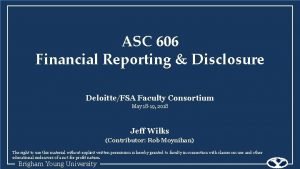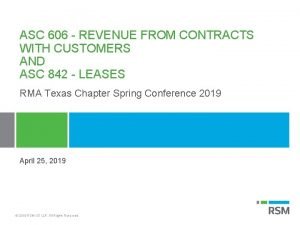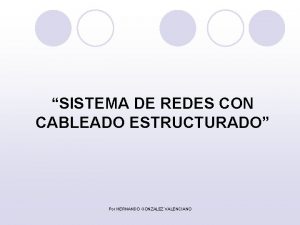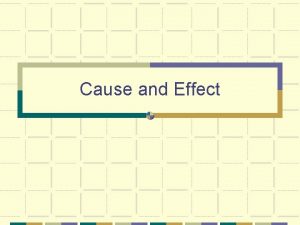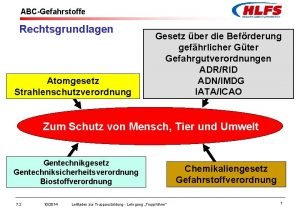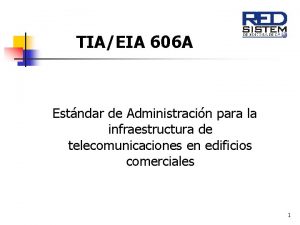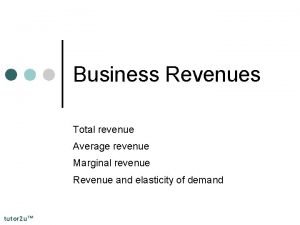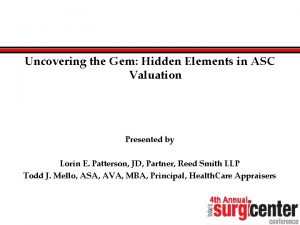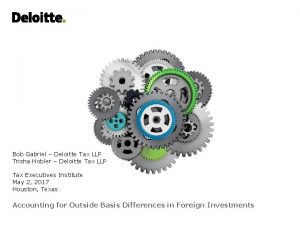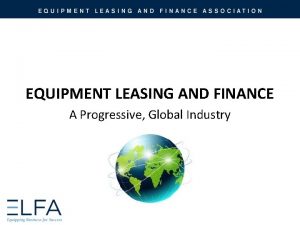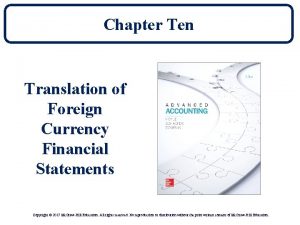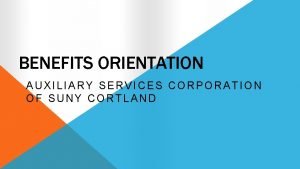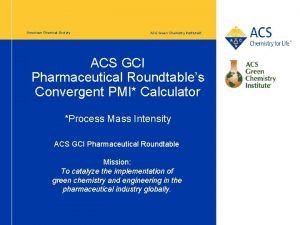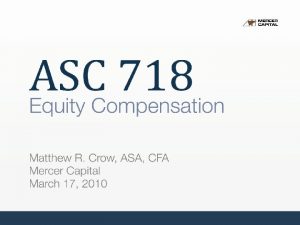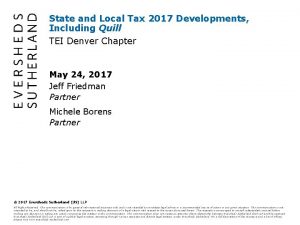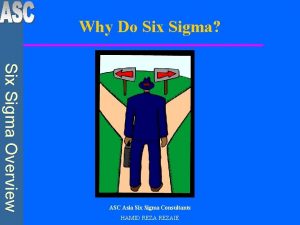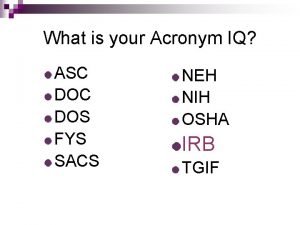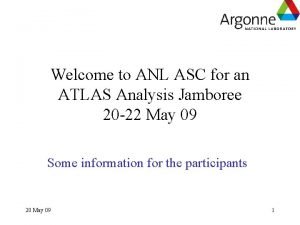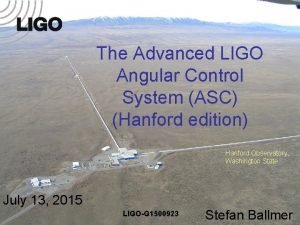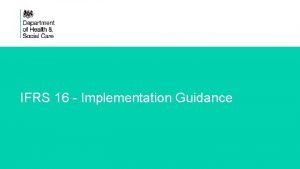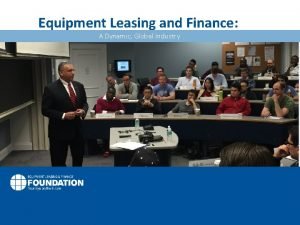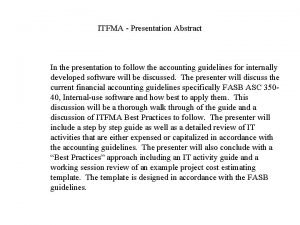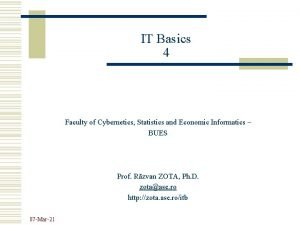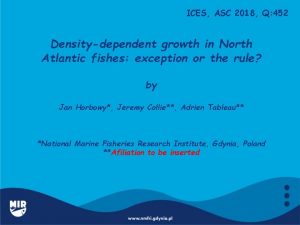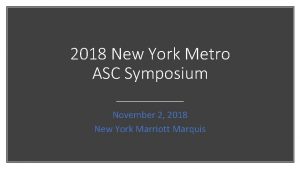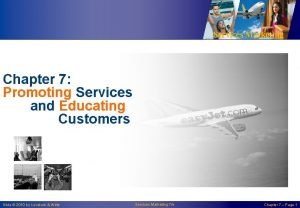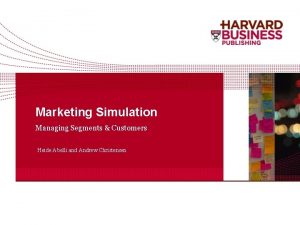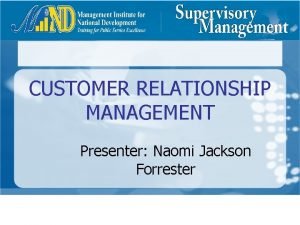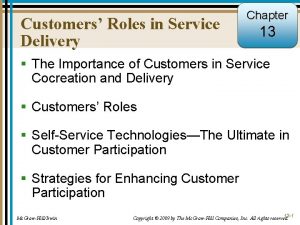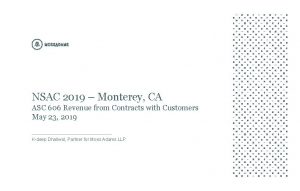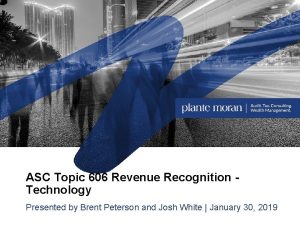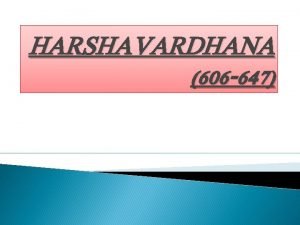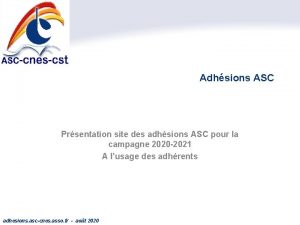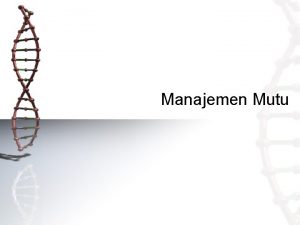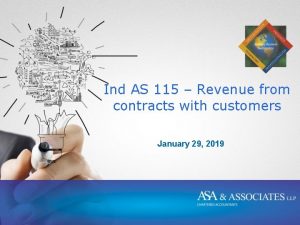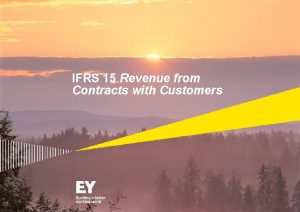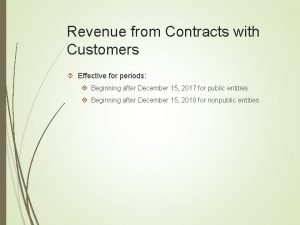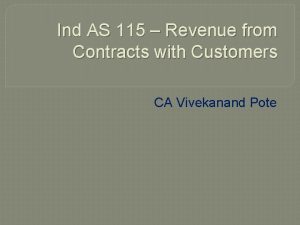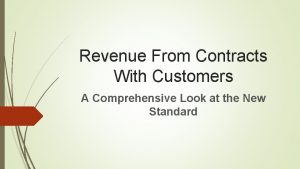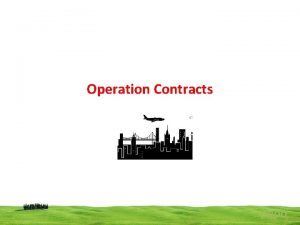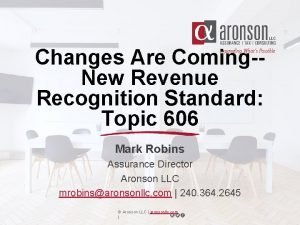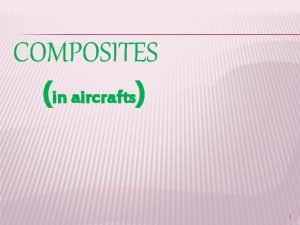ASC 606 REVENUE FROM CONTRACTS WITH CUSTOMERS AND
















































- Slides: 48

ASC 606 - REVENUE FROM CONTRACTS WITH CUSTOMERS AND ASC 842 - LEASES RMA Texas Chapter Spring Conference 2019 April 25, 2019 © 2019 RSM US LLP. All Rights Reserved.

Agenda • Introduction − Melanie Marshall − RSM Technical Accounting Consulting (“TAC”) • Overview of ASC 606: Revenue from Customers • Overview of ASC 842: Leases • Comparison of Significant Changes • Questions 1 © 2019 RSM US LLP. All Rights Reserved.

New Standards: Why should we care? • New framework for analyzing transactions, requires more: Judgment Estimation Disclosure ‒ Both ASC 606 (Revenue) and ASC 842 (Leasing) require additional support, analysis and documentation required by management • Financial statement metrics and debt covenants are impacted, so trends and forecasting changes must be considered • Historical valuation multiples and trends will change. Recasting is difficult. Public companies under 606 and private companies legacy GAAP. • Timing of liquidity events must be considered and evaluated to determine adoption methods and transaction structuring in light of new rules • Implementation time is significant so performing an assessment of the impact and having a detailed implementation plan is critical to a smooth and successful transition • Auditors will be required to test judgements and review supporting documentation so their involvement in the implementation process is needed • Standards can require changes in IT to comply with accounting and disclosure requirements 2 © 2019 RSM US LLP. All Rights Reserved.

OVERVIEW OF ASC 606: REVENUE FROM CONTRACTS WITH CUSTOMERS © 2019 RSM US LLP. All Rights Reserved.

Scope of ASC 606 • ASC 606 applies to all contracts with customers unless the customer contract is specifically within the scope of other guidance, such as: −Leases (ASC 840 or ASC 842) −Certain insurance contracts (ASC 944) −Various contractual rights and obligations related to financial instruments −Guarantees other than product or service warranties (ASC 460) −Certain nonmonetary exchanges −Contracts with a collaborator or a partner that has contracted with the entity to share in the risks and benefits that result from the collaborative activity or process (ASC 808) −Certain R&D funding arrangements (ASC 912 -730; ASC 730 -20) −Service concession arrangements (ASC 853) • May be applied to only part of a contract if only some elements are in the scope of other guidance • Industry: −No industry is scoped out −Replaces nearly all of the industry-specific revenue guidance under legacy US GAAP 4 © 2019 RSM US LLP. All Rights Reserved.

ASC 606: Adoption Methods and Key dates for private companies INITIATION AND PLANNING 5 © 2019 RSM US LLP. All Rights Reserved.

ASC 606 Core Principle 6 © 2019 RSM US LLP. All Rights Reserved.

5 -Step model for Revenue Recognition Under ASC 606 Identify the contract with the customer Contract with the customer is similar to legacy GAAP. Arrangements negotiated as a package must be combined. Identify the performance obligations in the contract Performance obligations are similar to deliverables, but they must be both capable of being distinct and distinct within the context of the contract. Determine the transaction price Allocate the transaction price Recognize revenue 7 © 2019 RSM US LLP. All Rights Reserved. Transaction price includes variable consideration, i. e. usage based fees, milestone payments, refunds, concessions, discounts, etc. Transaction price is allocated to each item based on its relative stand alone selling price (SSP). Discounts are allocated proportionately to all items. Revenue is recognized at a point in time (i. e. delivery) or over time (as services are provided) based on certain criteria.

ASC 606: What are the significant changes? • Contracts must still be legally enforceable, but can be oral or implied based on business practices. • Cash basis revenue recognition is not available when collectability is uncertain. Revenue deferral beyond cash collection may occur. • Performance obligations (products/services) are based on customer expectations of the promises to be provided. Must meet two criteria: capable of being distinct and distinct in the context of the contract. Could reach different conclusions under different contracts. • Returns are still estimated, but an estimate of value of the returned goods is recorded as an asset. • Options in contracts will result in revenue deferrals if price does not represent stand alone selling price for the good or service. • Stand alone selling prices (SSP) must be estimated for each performance obligation based on management’s estimate. 8 © 2019 RSM US LLP. All Rights Reserved.

ASC 606: What are the significant changes? (cont. ) • Revenue deferral is not required if the ultimate transaction price is not fixed. Must estimate variable consideration and changes in estimates impact revenue throughout the term of the contract. • Straight line amortization cannot be defaulted to for revenue recognition for items recognized over time. Revenue is recognized based on the pattern of performance. • Completed contract method is not available in situations where estimates of performance cannot be made. However, if an entity does not have a reasonable basis to measure its progress, revenue should not be recognized until progress can be measured. • Over time recognition is based on certain criteria and is required if criteria are met. Pattern of measurement of progress must be selected based on method that best depicts transfer of value and cannot change method until performance obligation fully satisfied. 9 © 2019 RSM US LLP. All Rights Reserved.

ASC 606: What are the significant changes? (cont. ) • Royalties related to licenses of IP are recognized upon the later of when the sale or usage occurs or the satisfaction of the performance obligation related to the IP. Guidance only applies to license of IP and cannot defer recognition until reporting received (must estimate once sales or usage has occurred). • Warranties that provide service in addition to the assurance that the product conforms to specifications will be a separate performance obligation and requires revenue allocation. • Costs related to customer contracts including costs to obtain a contract (i. e. commissions) and costs to fulfill a contract (i. e. direct labor) must be capitalized in certain circumstances. • Balance sheet presentation requires separate recognition of contract liabilities, accounts receivable and contract assets. • Disclosure requirements are significant and likely involve tracking (and disclosing) a variety of information not historically tracked or disclosed. 10 © 2019 RSM US LLP. All Rights Reserved.

Tax implications • Change in tax accounting method and approval from taxing authorities may be required if the method of revenue recognition and/or related costs changes for financial reporting purposes. • Changes in temporary differences will result in a change to deferred tax assets and liabilities. • Valuation allowances may require adjustments due to: − Changes in the timing of temporary difference reversals. − Changes in timing of future taxable income. • Disclosure requirements are significant and tax impacts associated with the adoption of the new standard must be disclosed for each financial statement line item. 11 © 2019 RSM US LLP. All Rights Reserved.

Audit implications RULES are being replaced by PRINCIPLES • Increased subjectivity necessitates changes in: − Financial processes − Increased controls (especially over the adoption of the standard) − Extensive documentation • Auditors and regulators will scrutinize management’s judgments (often with the benefit of hindsight) • Auditors will likely expect: − Increased involvement throughout the entire implementation process − Testing and review of company documentation related to: • • • Contract reviews Revenue streams Standalone selling price methodology Updated policies and procedures Footnote disclosures And much more… − Control testing over the adoption itself as well as new controls to mitigate the risks involved with implementing such a pervasive accounting standard 12 © 2019 RSM US LLP. All Rights Reserved.

Contract costs • Significant changes and impacts on contract acquisition (i. e. sales commissions) and fulfillment costs (i. e. professional services costs) ‒ Amortization period could extend beyond the contractual term ‒ Commissions must be aligned with revenue arrangements and allocated among the deliverables ‒ May require analysis of historical commissions and plans may change over time − Limited relief from practical expedient • If amortization period is one year or less can expense as liability is incurred • Requires careful consideration of renewal options, as well as, commission rates upon renewal − Accounting for sales commissions • Expected to be one of the most significant impacts as no longer can expense as liability is incurred unless practical expedient is met 13 © 2019 RSM US LLP. All Rights Reserved.

Presentation and Disclosure • Application of the guidance in ASC 606 may result in the recognition and presentation on the balance sheet of a contract asset or liability for the difference between the entity’s performance (i. e. , the goods or services transferred to the customer) and the customer’s performance (i. e. , the consideration paid by, and unconditionally due from, the customer). • Many new qualitative and quantitative disclosure requirements are included in ASC 606. The objective of the disclosure requirements is to help financial statement users understand the nature, amount, timing and uncertainty of revenue and related cash flows. 14 © 2019 RSM US LLP. All Rights Reserved.

Key 606 changes: Industry hot points Level of impact Low – Healthcare and all industries Medium - Consumer Products and Manufacturing Significant – Construction, Business Services, Technology • Focus on transfer of “control” instead of risks and rewards of ownership. • Collectibility assessment is more complex, and may result in delayed revenue recognition • Updated contract modification and combination guidance. • Limited method of allocation (SSP basis). • Financing components applied to both deferred and advance payments. • Enhanced disclosures • Updated consignment guidance (focus on control) • Variable consideration requires management judgment and use of estimates. All refunds, returns, discounts, rebates, penalties, and others will require further analysis. • Accounting for return/refund/exchange rights will change. Entities will need to implement new valuation requirements around return assets. • Recognition of revenue over time or at a point in time depends on whether one or more of three specific criteria are met, which will be subject to judgment and legal enforceability. • Certain warranties represent separate performance obligations. • Updated bill-and-hold guidance (less onerous) • Elimination of ALL industry-specific guidance. • Use of the residual method only permitted when pricing is highly variable or uncertain • Performance obligation is both capable of being distinct and distinct within the context of the contract. • Most software license revenue recognized up-front. • Licenses are evaluated to determine whether they include a right to use (point-intime) or a right to access (over time) IP. • Cannot presume that arrangements accounted for under the percentage-ofcompletion method under current guidance will continue to be recognized over time. • Royalties will require new estimation techniques. • Costs to obtain (commissions) or fulfill a customer contract must be capitalized in certain circumstances. 15 © 2019 RSM US LLP. All Rights Reserved.

16 © 2018 RSM US LLP. All Rights Reserved. © 2019 RSM US LLP. All Rights Reserved.

OVERVIEW OF ASC 842: LEASES © 2019 RSM US LLP. All Rights Reserved.

ASC 842: Adoption Methods and Key Dates Private companies are required to adopt ASC 842 starting in 2020. There is an optional transition method to use the effective date of ASC 842 as the date of initial application on transition. Companies that elect this transition option will not adjust their comparatives or make the new required lease disclosures for periods before the effective date. Advantages • Cost relief and reduced complexity from the application of the transition requirements 18 © 2019 RSM US LLP. All Rights Reserved. Disadvantages • Lack of comparability to prior years

Scope and definition of a lease 19 © 2019 RSM US LLP. All Rights Reserved.

Comparison to Legacy GAAP New Standard Asset is identified explicitly or implicitly Guidance does not address substitution rights Guidance says that there is no identified asset if the supplier has substantive substitution rights Customer has right to control the use of the identified asset Any one of the following criteria is met: The customer has both: • The customer operates the PP&E • The right to substantially all (>90%) the economic benefits from the use of the identified asset throughout the period of use • The customer controls physical access to PP&E • It is remote that other parties will take more than a minor amount of the output and certain pricing criteria are met 20 © 2019 RSM US LLP. All Rights Reserved. • The right to direct how and for what purpose the identified asset is used throughout the period of use

Lease classification criteria: Operating vs. Finance Transfer of Ownership at The lease transfers ownership of the underlying asset to the lessee by the end the End of the Lease of the lease term Term Purchase Option The lease grants the lessee an option to purchase the underlying asset that the Reasonably Certain to Be lessee is reasonable certain to exercise Exercised The lease term is for the major part of the remaining economic life of the Major Part of the Remaining Economic Life underlying asset Substantially All of the Fair Value of the Underlying Asset The present value of the sum of the lease payments and any residual value guaranteed by the lessee that is not already reflected in the lease payments equals or exceeds substantially all of the fair value of the underlying asset Underlying Asset Is Specialized The underlying asset is of such a specialized nature that it is expected to have no alternative use to the lessor at the end of the lease term Note: Although quantitatively not defined, major part and substantially all are viewed similar to the today’s lease guidance which would be 75% and 90%, respectively. 21 © 2019 RSM US LLP. All Rights Reserved.

Lease Classification Lessees and Lessors 22 © 2019 RSM US LLP. All Rights Reserved.

Lessee accounting 23 © 2019 RSM US LLP. All Rights Reserved.

Lessee accounting – short-term leases 24 © 2019 RSM US LLP. All Rights Reserved.

Overview of key changes - Lessees 25 © 2019 RSM US LLP. All Rights Reserved.

Overview of key changes - Lessees 26 © 2019 RSM US LLP. All Rights Reserved.

Lessee presentation Balance Sheet Right-of-use (ROU) asset: • Lease ROU assets can be presented separately or together with other assets • If not presented separately, disclose the line item where they are presented and the amount of lease ROU assets • Finance lease ROU assets are prohibited from being presented in the same line item as operating lease ROU assets Lease liability: • Lease liabilities can be presented separately or together with other liabilities • If not presented separately, disclose the line item where they are presented and the amount of lease liabilities • Finance lease liabilities are prohibited from being presented in the same line item as operating lease liabilities 27 © 2019 RSM US LLP. All Rights Reserved.

Lessee presentation (cont. ) Income statement Statement of cash flows Finance lease: No significant change from current GAAP Finance lease: • Principal payments within financing activities • Interest payments in accordance with ASC 230, Statement of Cash Flows Operating lease: • Lease-related interest expense and amortization presented in a manner consistent with how an entity presents interest expense and depreciation/amortization of similar assets Operating lease: • Lease expense included in income from continuing operations 28 © 2019 RSM US LLP. All Rights Reserved. • All payments within operating activities, except those payments made to bring an asset to the condition and location intended for its use are investing activities Both lease types: • Lease payments for short-term leases and variable lease payments (not included in lease liability) are within operating activities • Supplemental non-cash disclosure for new leases

Other key changes Financial metrics and tax impacts • The transition to the new standard could have additional financial statement and tax implications that will require consideration and evaluation. Some of the implications to be considered are: • Financial metrics, key performance indicators and capital structure impacts: • Key impacts relate to financial position (balance sheet) • Return on assets, debt-to-equity ratios and liquidity • Debt covenants, interest coverage ratios and EBITDA/EBIT levels • Potential changes to interest expense on finance leases due to changes in discount rate under ASC 842 • Potential impairment charges due to increase in long-lived assets (right-of-use asset) Tax • Recognition of lease-related assets and liabilities that are not on the balance sheet today would affect many aspects of accounting for income taxes, such as: • Recognition and measurement of deferred tax assets and liabilities • Assessment of recoverability of deferred tax assets and liabilities • Uncertainty around whether the ROU asset would be: • State and local tax: included in the property factor for apportionment of income • Sales and use tax: subject to sales tax • Property tax: included in property tax base subject to property taxes • Tax method accounting 29 © 2019 RSM US LLP. All Rights Reserved.

Lessee quantitative disclosure example 30 © 2019 RSM US LLP. All Rights Reserved.

Lessor recognition and measurement 31 © 2019 RSM US LLP. All Rights Reserved.

Lease Classification Lessees and Lessors 32 © 2019 RSM US LLP. All Rights Reserved.

Overview of key changes - Lessors 33 © 2019 RSM US LLP. All Rights Reserved.

Overview of key changes - Lessors 34 © 2019 RSM US LLP. All Rights Reserved.

Need for technology solution: Why not use Excel? Variable Rent CAM Base Rent Taxes / Insurance Components Purchase Subleasing Clauses Options Maintenance Extension Use 35 © 2019 RSM US LLP. All Rights Reserved. Termination

Need for ASC 842 technology solution A technology solution can help centralize all leases onto a single platform, perform calculations, assist with lease administration and provide necessary information for reporting: • Calculate future lease liability based on net present value (NPV) of future payments based on interest rates which could differ by contract. Systems will store appropriate data and calculate the liability automatically • Calculate the right of use (ROU) asset with adjustments, which can vary based on lease classification • Separate lease and non-lease components for accounting purposes, but make payments and record expenses in aggregate or as appropriate • Track terms including renewals, options, expirations, etc. ; terms can be stored within the system and notifications can be generated • More comprehensive disclosure reporting and systems can help with the quantitative disclosures – readily available reporting • Lease software can also be used to centralize and store lease information, process payments and assist in establishing controls over lease procurement 36 © 2019 RSM US LLP. All Rights Reserved.

Audit implications RULES are being replaced by PRINCIPLES • Increased subjectivity necessitates changes in: − Financial processes − Increased controls (especially over the adoption of the standard) − Extensive documentation • Auditors and regulators will scrutinize management’s judgments (often with the benefit of hindsight) • Auditors will likely expect: − Increased involvement throughout the entire implementation process − Testing and review of company documentation related to: • • • Lease identification Lease liability and ROU calculations Updated policies and procedures Footnote disclosures And much more… − Control testing over the adoption itself as well as new controls to mitigate the risks involved with implementing such a pervasive accounting standard 37 © 2019 RSM US LLP. All Rights Reserved.

ASC 842: Industries impacted Industry Types of Leases Consumer Products – Retail • Retail space • IT Hardware (PC’s, hard drives), POS equipment • Office equipment (Chairs, tables, shelving/display) Consumer Products – Restaurants • • Food & Beverage • Kitchen Equipment (HUD, range, oven, salamander, grill, deep-fryer, reach-in, walk-in, freezer) • POS equipment, IT hardware (PC’s, hard drives) • Tables, chairs Manufacturing • • • Healthcare • Medical and laboratory equipment (X-ray machines, lasers, MRI and CT scanners, surgical tables) • IT Hardware (PC’s, hard drives) Financial Services and Insurance • Commercial Space • IT Hardware (PC’s, hard drives) • Filings, office equipment, (Desks, chairs) 38 © 2019 RSM US LLP. All Rights Reserved. Retail space Kitchen Equipment (HUD, range, oven, salamander, grill, deep-fryer, reach-in, walk-in, freezer) IT hardware, POS Equipment (PC’s, hard drives) Tables, chairs, silverware Commercial vehicles Manufacturing equipment (Light, Medium, Heavy) IT Hardware (PC’s, hard drives) Industrial properties, construction equipment, materials handling equipment Office buildings, furniture, and equipment Long-term supply arrangements to secure raw materials, power and utilities, industrial gases and other supplies

39 © 2018 RSM US LLP. All Rights Reserved. © 2019 RSM US LLP. All Rights Reserved.

COMPARISON OF SIGNIFICANT CHANGES © 2019 RSM US LLP. All Rights Reserved.

Comparison of significant changes 606 Income statement considerations Balance sheet changes • Changes to allocation and timing of revenue, impacts to multiple element transactions and recurring/non-recurring revenue © 2019 RSM US LLP. All Rights Reserved. • Potential changes to interest expense on finance (capital) leases due to changes in discount rate • Changes in costs due to capitalization requirements • Initial direct costs may result in expensing certain costs previously capitalized • Potential impairment due to capitalization of commission costs • Potential impairment charges due to increase in long lived assets • New assets and liabilities due to changes in amount and timing of revenue recognition • Right of use asset recorded for all leases with a term greater than 12 months, operating and finance • Impact to retained earnings at the date of adoption for cumulative effect 41 842

Comparison of significant changes 606 Financial statement metrics • EBITDA changes due to changes in timing of revenue recognition and cost capitalization requirements 842 • Key impacts relate to financial position, return on assets, debt to equity ratios and liquidity • Valuation multiples and trends will change, consider need for trends for liquidity events • Impacts to debt covenants due to EBITDA changes and additional assets and liabilities Liquidity considerations 42 © 2019 RSM US LLP. All Rights Reserved. • Public company acquisitions of private companies in 2018 and private companies in 2019 and 2019 will require targets to be 2020 will require targets to be compliant within the quarter

Comparison of significant changes 606 Operational considerations • Adoption of the standard requires that two sets of books are maintained for some time period depending on adoption method • IT, finance, sales and legal may all be impacted 842 • IT solutions are typically needed to comply with the accounting and disclosure requirements • Time consuming process to gathering all leases and ensuring completeness • Judgements and estimates are • Embedded leases in service required and supporting and revenue arrangements are documentation is necessary difficult to identify and value Financial reporting • Significant level of disclosure needed • Advantages/disadvantages of practical expedients 43 © 2019 RSM US LLP. All Rights Reserved.

Transition challenges Transition to new standards brings with it certain challenges. The list below are some of the key challenges that companies may encounter as they transition to the new standards. Tone from the top Stakeholder identification Application of judgment and estimation Data management Internal controls and business processes Deal structure Covenants and other key performance indicators 44 © 2019 RSM US LLP. All Rights Reserved.

45 © 2018 RSM US LLP. All Rights Reserved. © 2019 RSM US LLP. All Rights Reserved.

© 2018 RSM US LLP. All Rights Reserved. © 2019 RSM US LLP. All Rights Reserved.

RSM US LLP 19026 Ridgewood Parkway San Antonio, Texas 1 210 828 6281 +1 800 274 3978 www. rsmus. com This document contains general information, may be based on authorities that are subject to change, and is not a substitute for professional advice or services. This document does not constitute audit, tax, consulting, business, financial, investment, legal or other professional advice, and you should consult a qualified professional advisor before taking any action based on the information herein. RSM US LLP, its affiliates and related entities are not responsible for any loss resulting from or relating to reliance on this document by any person. Internal Revenue Service rules require us to inform you that this communication may be deemed a solicitation to provide tax services. This communication is being sent to individuals who have subscribed to receive it or who we believe would have an interest in the topics discussed. RSM US LLP is a limited liability partnership and the U. S. member firm of RSM International, a global network of independent audit, tax and consulting firms. The member firms of RSM International collaborate to provide services to global clients, but are separate and distinct legal entities that cannot obligate each other. Each member firm is responsible only for its own acts and omissions, and not those of any other party. Visit rsmus. com/about us for more information regarding RSM US LLP and RSM International. RSM® and the RSM logo are registered trademarks of RSM International Association. The power of being understood® is a registered trademark of RSM US LLP. © 2019 RSM US LLP. All Rights Reserved.
 Deloitte asc 606 guide
Deloitte asc 606 guide Asc 340-40-25-1
Asc 340-40-25-1 Asc 606 short term lease
Asc 606 short term lease Ansi/tia/eia-606-a
Ansi/tia/eia-606-a Artigo 606 cpc
Artigo 606 cpc Honda cog commercial
Honda cog commercial 606 2814
606 2814 Vertical y horizontal
Vertical y horizontal Tia/eia 606-a
Tia/eia 606-a Regulamentul 606/2013
Regulamentul 606/2013 Average revenue vs marginal revenue
Average revenue vs marginal revenue Dtl dta
Dtl dta A muscular bag secretes gastric juice and mixes food around
A muscular bag secretes gastric juice and mixes food around Asc 740
Asc 740 Gem asc
Gem asc Asc tamu
Asc tamu Asc 52 attachment
Asc 52 attachment Asc cybersecurity
Asc cybersecurity Stress breaker dental
Stress breaker dental Asc 740 training
Asc 740 training Asc college panvel
Asc college panvel Trac leases asc 842
Trac leases asc 842 Gabriel deloitte
Gabriel deloitte A qué se dedica la asc
A qué se dedica la asc Asc 830
Asc 830 Asc suny cortland
Asc suny cortland Fas 141 real estate
Fas 141 real estate Pmi green chemistry
Pmi green chemistry Asc718
Asc718 Asc 450 decision tree
Asc 450 decision tree Sigma asc
Sigma asc Asc acronym
Asc acronym Atlas asc
Atlas asc Asc control system
Asc control system Kim fleck
Kim fleck Identifying a lease
Identifying a lease Equipment leasing and finance industry snapshot
Equipment leasing and finance industry snapshot Itfma 2019
Itfma 2019 Cybernetics statistics and economic informatics
Cybernetics statistics and economic informatics Ices asc
Ices asc Ny metro asc symposium new york
Ny metro asc symposium new york Basis risk arises due to
Basis risk arises due to Research and development contracts
Research and development contracts Promoting services and educating customers
Promoting services and educating customers Marketing simulation managing segments and customers
Marketing simulation managing segments and customers Naomi jackson alabama
Naomi jackson alabama Promoting services and educating customers
Promoting services and educating customers Customer contributions and roles in service delivery
Customer contributions and roles in service delivery Water contracts (gets smaller) when it freezes
Water contracts (gets smaller) when it freezes
